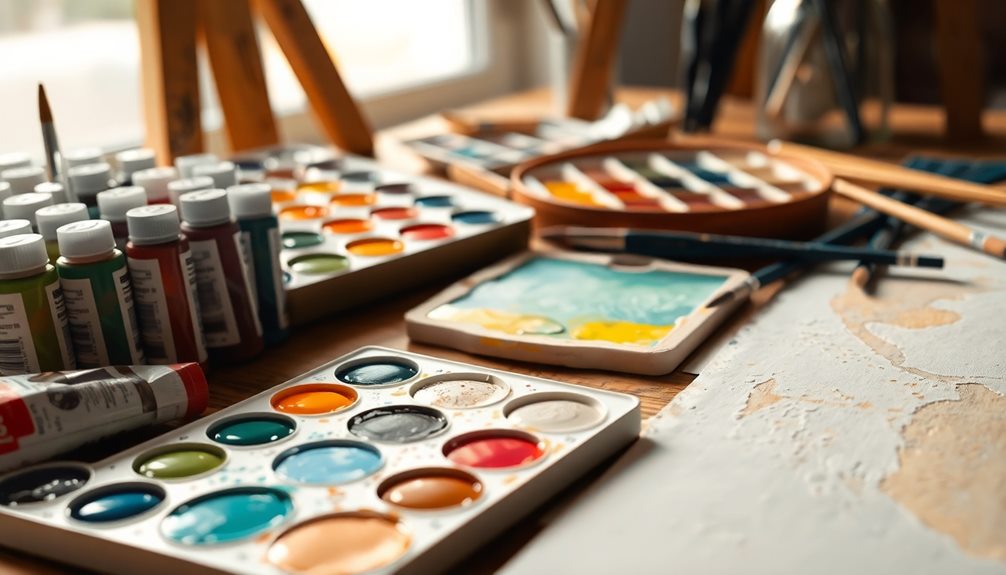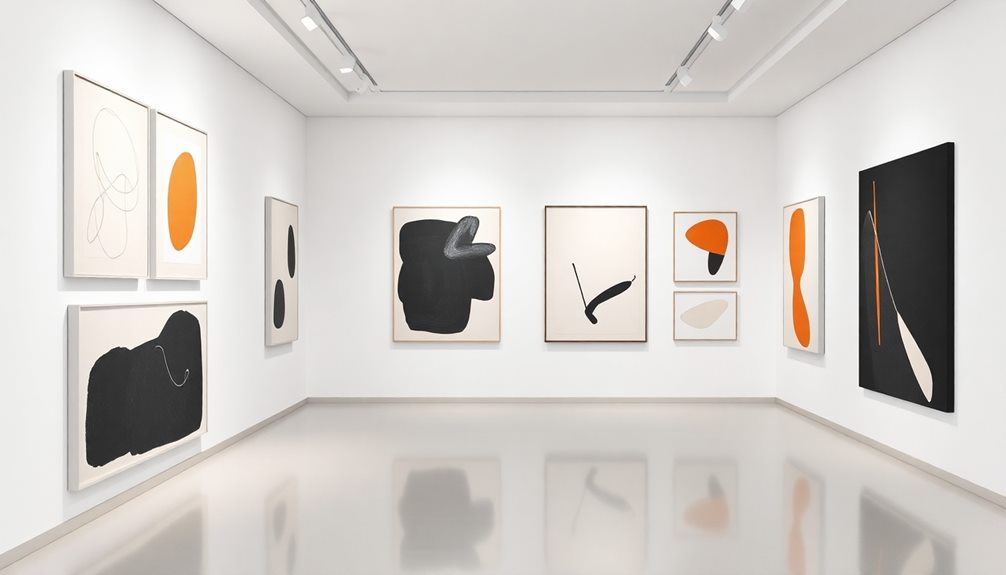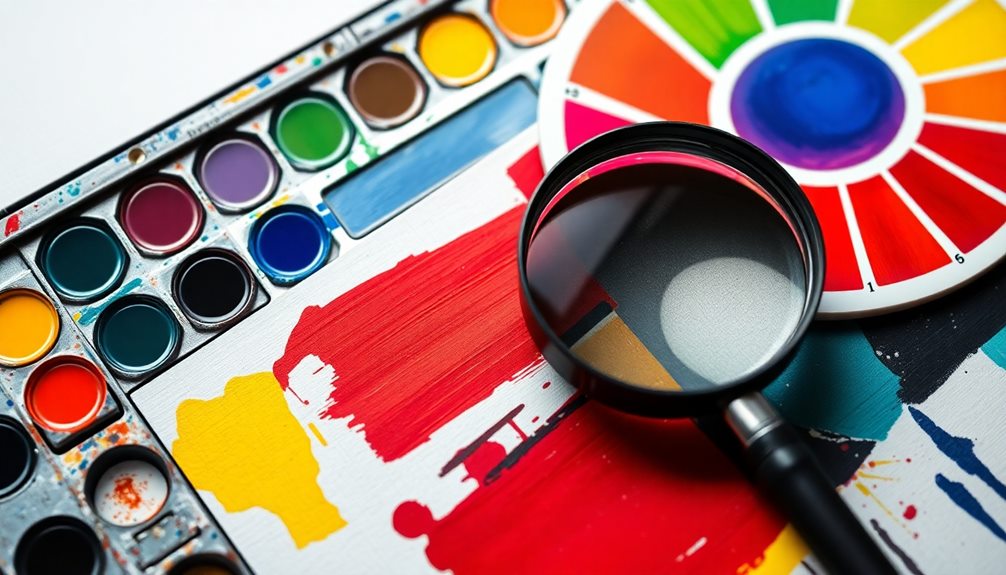In formalist art analysis, space and depth are crucial for grasping how artwork conveys meaning. By understanding positive and negative space, you can appreciate the overall composition. Techniques like overlapping and scale manipulation help create a sense of depth, guiding your eye and evoking emotions. Recognizing how distance between objects affects the viewer's perception also enhances your experience. For instance, artworks like Paul Cézanne's "The Basket of Apples" exemplify these principles beautifully. Explore these concepts further to uncover the richness behind spatial dynamics and their impact on your artistic interpretation.
Key Takeaways
- Space in art includes positive and negative elements, impacting overall composition and viewer perception.
- Techniques like overlapping and atmospheric perspective create a sense of depth and guide viewer's eye.
- Understanding spatial relationships enhances appreciation of emotional and intellectual experiences in artworks.
- Composition plays a crucial role in conveying meaning, highlighting relationships, and evoking emotional responses.
- Engaging with art through discussion enriches understanding of spatial dynamics and artistic intent.
Introduction

When you dive into the world of formalist art analysis, understanding space becomes essential. The concept of space refers to the physical or implied distance between objects in an artwork, playing a crucial role in viewer perception.
You'll notice that artists manipulate space through techniques like overlapping, scale changes, and atmospheric perspective, which all contribute to creating depth and enhancing emotional engagement. Effective preparation for consultations can also enhance your insights into spatial dynamics in art.
As you explore different artworks, you'll find that positive space includes the main subjects, while negative space surrounds them, influencing the overall composition. This balance between positive and negative space can significantly affect your interpretation of the piece.
Formalist critics focus on how these spatial relationships are constructed through technical aspects like perspective, demonstrating how they impact your experience as a viewer.
Key Concepts and Definitions

In the realm of formalist art analysis, grasping key concepts and definitions is vital for a deeper understanding of artworks. Space refers to the physical or implied distance between objects, which is crucial for how you perceive and interpret a piece. Within this context, positive space encompasses the primary objects in an artwork, while negative space refers to the surrounding areas that define those objects. Recognizing the interplay between these spaces allows you to appreciate an artwork's composition more fully.
Incorporating elements such as unique decor styles can enhance the visual experience, much like how positive and negative spaces interact in an artwork.
Depth is another essential concept, as it affects how you perceive spatial relationships within the artwork. Artists often use techniques like overlapping, scale manipulation, and atmospheric perspective to create a sense of depth, guiding your eye through the composition.
By understanding these spatial relationships, you gain insight into the interactions between objects and how they contribute to the overall meaning of the piece. The manipulation of space can evoke various emotions and meanings, influencing your overall experience of the artwork.
Essential Elements of Analysis

Understanding the essential elements of analysis is crucial for effectively engaging with art. One key aspect is the concept of space, which refers to the physical or implied distance between objects. Recognizing positive space—the main subjects of a composition—versus negative space, the areas surrounding them, helps you appreciate the artwork's overall structure.
Just as essential oils can enhance well-being by addressing specific needs, understanding spatial relationships in art can elevate your experience. For instance, essential elements of analysis can help you perceive the depth and context within a piece.
The arrangement of elements, known as composition, significantly impacts how you perceive space and the emotional responses it evokes. Artists often use techniques like overlapping, scale changes, and atmospheric perspective to manipulate space, creating a sense of depth that invites you into the artwork.
Paying attention to spatial relationships enhances your understanding of how elements interact within the piece. For instance, the distance between subjects can convey tension or harmony, influencing how you interpret the work.
Notable Artworks for Analysis

Art offers a rich tapestry of works that exemplify the intricate play of space and depth, making them ideal for analysis. Take Paul Cézanne's "The Basket of Apples," for instance. His overlapping forms and perspective create a compelling sense of depth and dimensionality that draws your eye.
Similarly, Jackson Pollock's "No. 5, 1948" showcases space's manipulation through dynamic lines and colors, evoking movement and a visceral depth in abstraction.
Piet Mondrian's "Broadway Boogie Woogie" uses geometric shapes within a grid-like composition to suggest spatial relationships, rhythm, and the interplay between positive and negative space, captivating your attention.
Georgia O'Keeffe's "Sky Above Clouds IV" captures the illusion of depth through its color gradation and atmospheric perspective, inviting viewers into an expansive sky.
Lastly, Edward Hopper's "Nighthawks" effectively utilizes space to create a sense of isolation and depth, contrasting the diner's warm interior against the cool urban night.
Each of these artworks not only showcases the elements of space and depth but also captivates the viewer's eye, prompting further exploration and analysis.
Tips and Best Practices

When analyzing artworks, grasping the difference between positive and negative space is essential for interpreting their composition. Positive space includes the main subjects, while negative space refers to the surrounding areas that impact how you perceive the artwork.
Familiarize yourself with the techniques artists use to create depth, such as overlapping objects, varying scale, and atmospheric perspective. These methods can enhance emotional engagement and guide your interpretation.
Examine spatial relationships within the artwork. Consider how elements like perspective and composition influence your eye movement and evoke specific feelings. Recognizing the interplay of positive and negative space can reveal hidden meanings and intentions behind the piece.
Don't forget to apply both formalist and contextualist approaches. While formalist critiques focus on the technical aspects—like the Elements of Art and Principles of Design—contextualists explore broader cultural and historical influences.
Lastly, employ visual analysis strategies. Identify how elements are arranged and how they interact within the composition. This practice deepens your understanding and appreciation of the spatial dynamics in artworks, leading to a more insightful analysis.
Audience Engagement and Feedback

To foster a deeper connection with formalist art analysis, encouraging audience engagement is crucial. When you interact with art, pay close attention to the spatial relationships within the piece. This observation enhances your understanding of depth and composition, allowing you to appreciate how artists manipulate positive and negative space.
Engaging discussions about these elements can reveal how they contribute to the overall meaning and aesthetic experience of the artwork. Feedback from you, the audience, is invaluable. It provides insights into how effectively artists influence viewer perception through technical aspects of their work.
Structured critique sessions enable you to articulate your thoughts on space and depth, deepening your appreciation for formalism. By asking questions about spatial arrangements and perspectives, you can spark richer dialogues about the significance of space in both formalist and contextual interpretations.
Ultimately, your engagement not only enriches your experience but also enhances the collective understanding of how spatial dynamics function in art. So, dive in, share your interpretations, and explore the artwork's depth with others; your insights can illuminate the intricate relationship between audience engagement and formalist art analysis.
Artistic Intent and Interpretation

Engaging with formalist art analysis naturally leads to a focus on artistic intent and interpretation. When you examine an artwork, pay close attention to how the artist manipulates the use of space and the elements and principles of design. The composition is vital; it guides your perception and emotional response, revealing the artist's intentions.
For instance, the interplay of positive and negative space can significantly impact how you experience an artwork. The arrangement of subjects in relation to their surroundings not only creates an illusion of depth but also highlights crucial relationships. By analyzing lines, colors, and shapes, you can uncover how these elements contribute to the overall meaning of the piece.
Understanding spatial relationships within a composition allows you to appreciate the emotional or intellectual experiences that the artwork evokes. Artists often employ spatial techniques to elicit specific feelings, making your interpretation more nuanced.
Additional Resources

Exploring additional resources can significantly enhance your understanding of formalist art analysis and the manipulation of space within artworks. To dive deeper, consider studying how artists use elements like overlapping and scale manipulation to create depth.
You'll find that analyzing both positive space—the main subjects—and negative space—the areas surrounding them—can profoundly affect your perception and emotional response to the piece.
Books and articles focused on compositional techniques will help you grasp how space is constructed within an artwork. Understanding terms such as perspective, composition, and negative space will elevate your analysis, allowing you to appreciate the relationships between objects and their surroundings more fully.
Additionally, online courses or workshops can provide practical exercises in recognizing these elements in various artworks, reinforcing your understanding.
You might also explore critiques by formalist critics, who emphasize the technical aspects rather than the subject matter, to see how they interpret space and depth. Engaging with these resources won't only boost your analytical skills but also enrich your emotional engagement with art.
Frequently Asked Questions
What Factors Are Considered in a Formalist Analysis of Artwork?
In a formalist analysis, you consider composition, color, line, and texture. You focus on how these elements interact, creating visual harmony or tension, while disregarding context to emphasize the artwork's intrinsic qualities and technical execution.
What Is an Artistic Technique Used to Give an Illusion of Space and Depth?
An artistic technique you can use to create an illusion of space and depth is perspective. By adjusting the size and placement of objects, you can effectively guide the viewer's eye through a three-dimensional scene.
What Is Depth and Dimension in Art?
Depth in art creates a sense of three-dimensionality, while dimension refers to the physical space an artwork occupies. You can enhance both by using techniques like overlapping, varying sizes, and manipulating negative space.
What Is the Space in Art Perspective?
In art, space perspective refers to how you perceive distance and arrangement of objects. It involves techniques like overlapping and scale to create a sense of depth, guiding your eye throughout the composition.
Conclusion
In conclusion, exploring space and depth in formalist art analysis enriches your understanding of visual dynamics. By grasping key concepts and applying essential elements, you can appreciate artworks on a deeper level. Remember to engage with your audience and consider the artist's intent, as these factors can significantly shape interpretation. As you continue your journey in art analysis, don't hesitate to seek out additional resources that can expand your perspective and enhance your skills.









